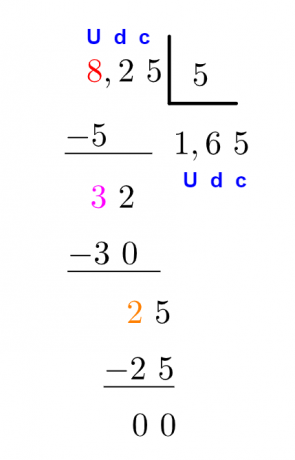
In many situations we need to solve split accounts with decimal numbers. For example, if four pens cost R$11.20, what is the price of each pen?
To find the answer we have to divide a number in decimal form by a natural number: . So, each pen costs R$2.80.
But how did we arrive at this answer? If you still don't know or have questions about how to solve accounts like this, you're in the right place! In this post, we will teach how to divide decimal numbers.
Example 1: Divide the number 235.7 by 10, by 100 and by 1000.
Example 2: Divide the number 1.96 by 10, by 100 and by 1000.
This rule can be generalized to values other than 10, 100 and 1000. If, for example, you want to divide a decimal number by 1,000,000, which is a number with 6 digits equal to 0, just move the decimal point six places to the left.
First, let's remember that every decimal number has an integer part, formed by units (U), tens (D), hundreds (C) etc., and a decimal part formed by tenths (d), hundredths (c), thousandths (m) etc.
That said, let's see an example of how to divide a decimal number by any natural number.
Example: Calculate

There is an alternative method to resolve this same account. what we do is delete the comma and then solve the division account between natural numbers.
To delete the comma:
And so on.
Since 8.25 has two places after the decimal point, we multiply by 100:
Although the number 5 does not have a comma, we must also multiply it by 100. We will always multiply the two account numbers, dividend and divisor, by the same number.
So solve is the same as solving
, that is, to solve a division between natural numbers.

To divide a decimal number by another decimal number, we will adopt the procedure of transforming the account into natural number division, eliminating the commas.
To delete the comma:
And so on.
Example 1: Calculate .
Then, .
Example 2: Calculate .
Note that even though the number 0.8 only has one place after the decimal point, we multiply it by 100. We did this because the number 0.02 needs to be multiplied by 100 and the two account numbers must be multiplied by the same number.
Thus, .
See too:


